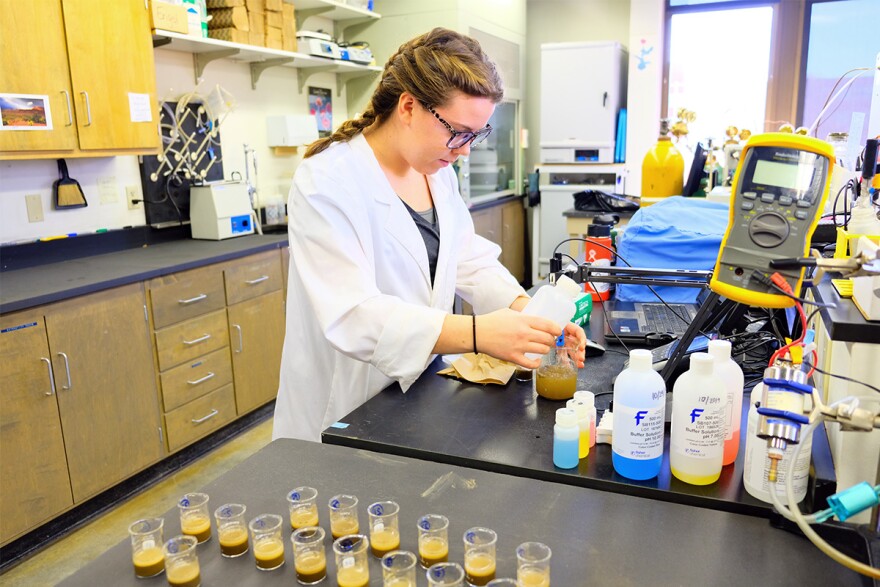Across Montana, many farmers are noticing parts of their fields where nothing will grow, not even weeds. Researchers at Montana State University are wrapping up a multi-year project to figure out what farmers can do.
Three hundred surveys were mailed last week to farmers in Chouteau, Yellowstone, Valley, Daniels and Pondera counties: places where in some areas the soil is becoming so acidic that crops won't grow.
“The goals of the survey are to find out what farmers already know about the problem, what they might know about the solutions to the problem, what they’re perhaps trying on the farm if they already have soil acidity or low pH, and then what direction they think our research and outreach should take,” says Clain Jones, MSU's Soil Fertility Extension Specialist and the person in charge of the survey.
The problem he’s talking about is called soil acidification. Too much nitrogen fertilizer is the main cause. While soil acidification is a fairly common problem in the Midwest and other parts of the world, researchers only started noticing it in Montana in 2015.
Jones is one of the people trying to help farmers recognize it and figure out what can be done. He says no one was really expecting soil acidification in Montana because the state traditionally has had very low-acidic soils.
On the pH scale of 0 to 14, they’ve been around seven and eight. That’s on par with water and eggs, respectively. But now, according to Jones, the pH in some farms' soil is dropping.
“We’re seeing some pH’s as low as four in Montana. At four, essentially nothing grows,” he said.
Not even weeds?
“Definitely not even weeds,” he said, laughing.
For reference, tomato juice also has a pH of four.
Since Montana doesn’t get much rain and a lot of farmers have switched to no-till practices, Jones says most of the acidity stays in the top three inches of soil, right where the seeds are trying to germinate and grow.
“So to me it’s really scary because we’re seeing farms that have no production in certain areas and reduced yields elsewhere. With current, low commodity prices, somewhat high input costs, a lot of producers are already struggling financially. This is just one more thing that could cause a producer to go out of business or have additional stress due to poor revenue,” Jones said.
Soil acidification has been reported in 23 of Montana’s 56 counties. It’s most prevalent in Chouteau County where Ron Long and his son run a farm.
Long says about twenty years ago, they started noticing patches of their fields with spindly, low-yielding crops.
“And we thought it must be something nutritional or a disease problem,” Long said.
In some areas, he says plants would die only a few inches high. It got to the point where yields were down 20 percent.
“Finally somebody figured out that we were having this shallow acid layer,” Long said.
Long says they tried mixing in some lime, a basic byproduct of sugar beet processing from a facility in Billings to balance his acidic soil.
“Where we put it on and worked it into that acid zone, we saw results immediately, big results," Long said.
Long says yields went from 10 to 15 bushels of winter wheat per acre to 40 to 50. Now he uses satellite images from the local fertilizer co-op and a hand held pH monitor to figure out which areas of the farm need lime the most.
While the sugar beet facilities in Billings and Sydney give away lime for free, farmers still have to pay to move it, which can add up when you’re dealing with thousands of acres. It also can take a lot of time to mix it into the soil and sometimes requires special equipment.
By knowing exactly how much lime is needed to fix the problem, farmers could save valuable time and money.
Back at MSU, soil scientist Richard Engel is trying to pinpoint that.
Meagan Key, a student who works in his lab, sticks a pH probe into a beaker with a soil sample.

The samples were collected from several locations in Chouteau County where Engel and his team applied different amounts of lime in 2017. Results from the study will come out early next year.
Regardless of how much lime a farmer puts on a field, Engel says it needs to be tilled into the soil to be effective.
“There is some maybe reluctance to till soil by some of these no-till farmers, but a single tillage event every 15 to 20 years is not going to hurt your soil,” Engel said.
MSU Extension Specialist Clain Jones says it’s best if farmers can catch soil acidification early on, before the only option is adding lime.
“Producers really need to think about how they’re going prevent it, which means using nitrogen more efficiently, maybe using more pulse crops or legumes in rotation, planting more perennials. All those things appear to decrease the risk of acidification,” Jones said.
He says funding for the research project will end in 2020, but he’s hopeful they can get more to continue working on this issue.





